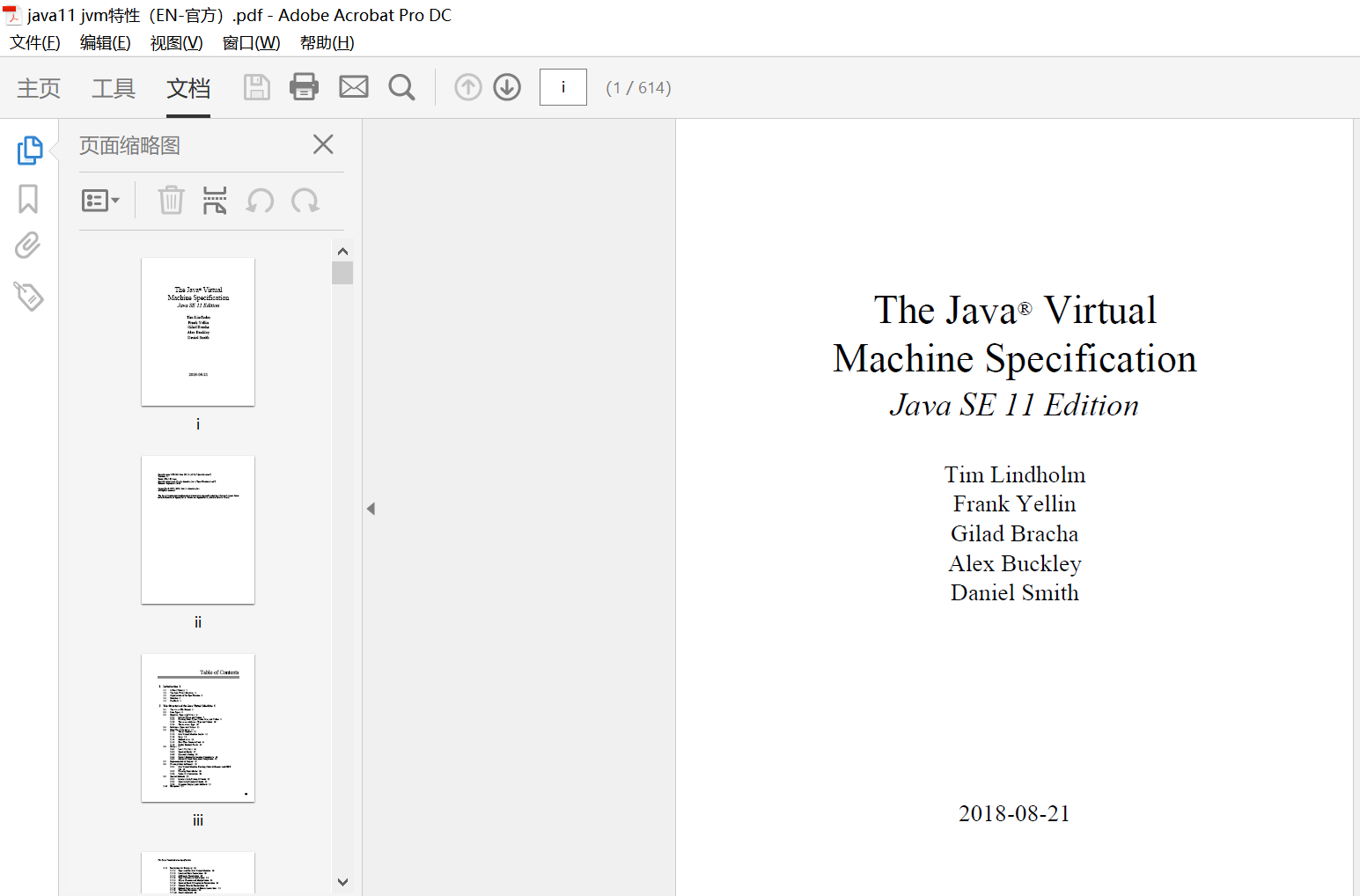java11jvm特性(EN-官方)

THIS document specifies an abstract machine. It does not describe any particular implementation of the Java Virtual Machine. To implement the Java Virtual Machine correctly, you need only be able to read the class file format and correctly perform the operations specified therein.
Implementation details that are not part of the Java Virtual Machine's specification would unnecessarily constrain the creativity of implementors. For example, the memory layout of run-time data areas, the garbage-collection algorithm used, andany internal optimization of the Java Virtual Machine instructions (for example, translating them into machine code) are left to the discretion of the implementor.
All references to Unicode in this specification are given with respect to TheUnicode Standard, Version 10.0.0, available at http://www.unicode.org/.
2.1 The class File Format
Compiled code to be executed by the Java Virtual Machine is represented usinga hardware- and operating system-independent binary format, typically (but notnecessarily) stored in a file, known as the class file format. The class file formatprecisely defines the representation of a class or interface, including details suchas byte ordering that might be taken for granted in a platform-specific object fileformat.
Chapter 4, "The class File Format", covers the class file format in detail.
2.2 Data Types
THE STRUCTURE OF THE JAVA VIRTUAL MACHINE
Like the Java programming language, the Java Virtual Machine operates on two kinds of types: primitive types and reference types. There are, correspondingly, two kinds of values that can be stored in variables, passed as arguments, returned by methods, and operated upon: primitive values and reference values.
The Java Virtual Machine expects that nearly all type checking is done prior to run time, typically by a compiler, and does not have to be done by the Java Virtual Machine itself. Values of primitive types need not be tagged or otherwise be inspectable to determine their types at run time, or to be distinguished from values of reference types. Instead, the instruction set of the Java Virtual Machine distinguishes its operand types using instructions intended to operate on values of specific types. For instance, iadd, ladd, fadd, and dadd are all Java Virtual Machine
instructions that add two numeric values and produce numeric results, but each is specialized for its operand type: int, long, float, and double, respectively. For a summary of type support in the Java Virtual Machine instruction set, see §2.11.1.
The Java Virtual Machine contains explicit support for objects. An object is either a dynamically allocated class instance or an array. A reference to an object is considered to have Java Virtual Machine type reference. Values of type reference can be thought of as pointers to objects. More than one reference to an object may exist. Objects are always operated on, passed, and tested via values of type reference.
2.3 Primitive Types and Values
The primitive data types supported by the Java Virtual Machine are the numeric types, the boolean type (§2.3.4), and the returnAddress type (§2.3.3).
The numeric types consist of the integral types (§2.3.1) and the floating-point types
(§2.3.2).
The integral types are:
• byte, whose values are 8-bit signed two's-complement integers, and whose default value is zero
• short, whose values are 16-bit signed two's-complement integers, and whose default value is zeroTHE STRUCTURE OF THE JAVA VIRTUAL MACHINE
Primitive Types and Values
2.37
• int, whose values are 32-bit signed two's-complement integers, and whose default value is zero
• long, whose values are 64-bit signed two's-complement integers, and whose default value is zero
• char, whose values are 16-bit unsigned integers representing Unicode code points in the Basic Multilingual Plane, encoded with UTF-16, and whose default value is the null code point ('\u0000')
The floating-point types are:
• float, whose values are elements of the float value set or, where supported, the float-extended-exponent value set, and whose default value is positive zero
• double, whose values are elements of the double value set or, where supported, the double-extended-exponent value set, and whose default value is positive zero
The values of the boolean type encode the truth values true and false, and the default value is false.
The First Edition of The Java® Virtual Machine Specification did not consider boolean to be a Java Virtual Machine type. However, boolean values do have limited support in the Java Virtual Machine. The Second Edition of The Java® Virtual Machine Specification clarified the issue by treating boolean as a type.
The values of the returnAddress type are pointers to the opcodes of Java Virtual Machine instructions. Of the primitive types, only the returnAddress type is not directly associated with a Java programming language type.
2.3.1 Integral Types and Values
The values of the integral types of the Java Virtual Machine are:
• For byte, from -128 to 127 (-27 to 27
- 1), inclusive
• For short, from -32768 to 32767 (-215 to 215 - 1), inclusive
• For int, from -2147483648 to 2147483647 (-231 to 231 - 1), inclusive
• For long, from -9223372036854775808 to 9223372036854775807 (-263 to 263
- 1), inclusive
• For char, from 0 to 65535 inclusive2.3
Primitive Types and Values
THE STRUCTURE OF THE JAVA VIRTUAL MACHINE
8
2.3.2 Floating-Point Types, Value Sets, and Values
The floating-point types are float and double, which are conceptually associated with the 32-bit single-precision and 64-bit double-precision format IEEE 754 values and operations as specified in IEEE Standard for Binary Floating-Point Arithmetic (ANSI/IEEE Std. 754-1985, New York).
The IEEE 754 standard includes not only positive and negative sign-magnitude numbers, but also positive and negative zeros, positive and negative infinities, and a special Not-a-Number value (hereafter abbreviated as "NaN"). The NaN value is used to represent the result of certain invalid operations such as dividing zero by zero.
Every implementation of the Java Virtual Machine is required to support two standard sets of floating-point values, called the float value set and the double value set. In addition, an implementation of the Java Virtual Machine may, at its option, support either or both of two extended-exponent floating-point value sets, called the float-extended-exponent value set and the double-extended-exponent value set.
These extended-exponent value sets may, under certain circumstances, be used instead of the standard value sets to represent the values of type float or double.
The finite nonzero values of any floating-point value set can all be expressed in the form s ⋅ m ⋅ 2(e - N + 1), where s is +1 or -1, m is a positive integer less than2N, and e is an integer between Emin = -(2K-1-2) and Emax = 2K-1-1, inclusive, and where N and K are parameters that depend on the value set. Some values can be represented in this form in more than one way; for example, supposing that a
value v in a value set might be represented in this form using certain values fors, m, and e, then if it happened that m were even and e were less than 2K-1, one could halve m and increase e by 1 to produce a second representation for the same value v. A representation in this form is called normalized if m ≥ 2N-1; otherwise the representation is said to be denormalized. If a value in a value set cannot be represented in such a way that m ≥ 2N-1, then the value is said to be a denormalized value, because it has no normalized representation.
The constraints on the parameters N and K (and on the derived parameters Emin and Emax) for the two required and two optional floating-point value sets are summarized in Table 2.3.2-A.
【下载地址】
百度网盘链接:https://pan.baidu.com/s/1tTsKk1OCAsnZkESVVJ-nZg
提取码:m9br
相关文章
使用-JFreeChart来创建基于web的图表
XStream使用文档
WebService发布过程及常见问题
webpack实战入门进阶调优分享
weblogic调优参数及监控指标
weblogic节点管理
weblogic管理控制台概述
weblogic-部署和启动
WebLogic-Server-性能及调优-调优-Java-虚拟机
Java 虚拟机(Java virtual machine,简称 JVM)是一种虚拟“执行引擎”实例,可在微处理器上执行 Java 类文件中的字节码。调整 JVM 的方式会影响 Weblogic Server 和应用程序的性能。
Velocity是一个基于java的模板引擎(template engine)。它允许任何人仅仅简单的使用模板语言(template language)来引用由java代码定义的对象。
Velocity 用户手册是帮助页面设计者和内容提供者认识 Velocity 和其简单而功能强大的脚本语言――Velocity 模板语言(VTL)。在手册上的许多例子,都是用 Velocity 插入动态的内容到网页上,但是所有的 VLT 例子都能应用到其他的页面和模板中。
FlashFXP绿色版网盘下载,附激活教程 2667
FlashFxp百度网盘下载链接:https://pan.baidu.com/s/1MBQ5gkZY1TCFY8A7fnZCfQ。FlashFxp是功能强大的FTP工具
Adobe Fireworks CS6 Ansifa绿色精简版网盘下载 2513
firework可以制作精美或是可以闪瞎眼的gif,这在广告领域是需要常用的,还有firework制作下logo,一些原创的图片还是很便捷的,而且fireworks用法简单,配合dw在做网站这一块往往会发挥出很强大的效果。百度网盘下载链接:https://pan.baidu.com/s/1fzIZszfy8VX6VzQBM_bdZQ
navicat for mysql中文绿色版网盘下载 2289
Navicat for Mysql是用于Mysql数据库管理的一款图形化管理软件,非常的便捷和好用,可以方便的增删改查数据库、数据表、字段、支持mysql命令,视图等等。百度网盘下载链接:https://pan.baidu.com/s/1T_tlgxzdQLtDr9TzptoWQw 提取码:y2yq
火车头采集器(旗舰版)绿色版网盘下载 2488
火车头采集器是站长常用的工具,相比于八爪鱼,简洁好用,易于配置。火车头能够轻松的抓取网页内容,并通过自带的工具对内容进行处理。站长圈想要做网站,火车头采集器是必不可少的。百度网盘链接:https://pan.baidu.com/s/1u8wUqS901HgOmucMBBOvEA
Photoshop(CS-2015-2023)绿色中文版软件下载 2498
安装文件清单(共46G)包含Window和Mac OS各个版本的安装包,从cs到cc,从绿色版到破解版,从安装文件激活工具,应有尽有,一次性打包。 Photoshop CC绿色精简版 Photoshop CS6 Mac版 Photoshop CC 2015 32位 Photoshop CC 2015 64位 Photoshop CC 2015 MAC版 Photoshop CC 2017 64位 Adobe Photoshop CC 2018 Adobe_Photoshop_CC_2018 Photoshop CC 2018 Win32 Photoshop CC 2018 Win64
